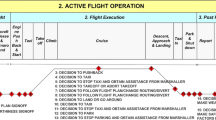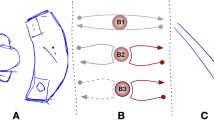Abstract
Recent incidents have shown that the production of take-off speeds is an activity vulnerable to miscalculations with a potential for disastrous outcomes. The aim of this paper is to analyze the calculation of the take-off speeds in a modern airline cockpit as a distributed cognitive activity in order to identify possible vulnerabilities in this process. We took the cockpit as the joint cognitive system under analysis and conducted an ethnographic study based on documental analysis, flight observations, interviews, and the analysis of 22 events involving failures related to the calculation of take-off speeds. The main argument is that the cognitive systems engineering perspective, with less focus on the human contribution than it is common in investigations, levels people and artifacts in the system as equal contributors to its eventual performance. Our analysis identified four assertions regarding vulnerabilities in the process of take-off speeds calculation: (1) representations at the level of the cockpit are always partial and incomplete; (2) some interactions require interpretation rather than institution; (3) interactions of agents do not follow a canonical process of coordination; (4) the control of the prevention of failures is accurate but inadequate. These vulnerabilities are a matter of interactions among cognitive systems in the cockpit, rather than vulnerabilities of individual agents, such as humans or artifacts.

Similar content being viewed by others
Notes
Gross Weight (GW), sometimes also referred as Take-off Weight (TOW) or Actual Take-off Weight (ATOW)—is the entire weight of the airplane, including fuel, passengers, and luggage. The airplane’s take-off gross weight is the gross weight at the beginning of take-off and is used as the basis for the calculation of take-off speeds.
V1—Take-off decision speed—is the speed during take-off for which it is the last possible moment, in the event of an engine failure or rejected take-off, to safely stop the airplane on the remaining runway.
Vr—Rotation speed—is the speed during take-off at which the pilot starts to rotate to the lift-off attitude in order to start flying.
V2—Take-off safety speed—is the initial climb out speed used after lift-off to achieve a certain height in a certain distance, in order to ensure adequate control and climb performance in case of an engine failure.
EFB—Electronic Flight Bags are devices that display a variety of aviation data or perform basic calculations (e.g. performance data, fuel calculations, etc.). In the past, some of these functions were traditionally accomplished using paper references or were based on data provided to the flight crew by a flight dispatcher. The scope of the EFB system functionality may also include various other hosted databases and applications. Physical EFB displays may use various technologies, formats, and forms of communication. These devices are sometimes referred to as auxiliary performance computers (APC) or laptop auxiliary performance computers (LAPC).
ACARS—Aircraft Communications Addressing and Reporting System is a digital data link system for transmission of messages between the aircraft and ground stations.
References
Accident Investigation Board Denmark (1999) Summary report, Boeing 767-383, Copenhagen Airport. Author, Copenhagen. Retrieved from http://www.havarikommissionen.dk/graphics/Synkron-Library/hcl/dokumenter/Redegorelser/1999/49-99-KDN-UK.pdf
Accident Investigation Board Norway (2004) Incident, early rotation on take-off, Oslo Airport Gardemoen, 04 September 2003, Airbus A321-232 (AIBN, Report number SL 40/2004, 01-Nov-2004). Author, Lillestrom, Norway. Retrieved from http://www.aibn.no/luftfart/rapporter/2004-40-eng
Airbus (2004a) Flight operations briefing notes. Standard operating procedures: normal checklists (technical document). Retrieved from http://www.airbus.com/index.php?id=781
Airbus (2004b) Flight operations briefing notes. Takeoff and departure operations: understanding takeoff speeds (technical document). Retrieved from http://www.airbus.com/index.php?id=781
Airbus (2005) Flight operations briefing notes. Takeoff and departure operations: preventing tail strikes at takeoff (technical document). Retrieved from http://www.airbus.com/index.php?id=781
Ashby WR (1959) Requisite variety and its implications for the control of complex systems. Cybernetica 1:83–99. Retrieved from http://pespmc1.vub.ac.be/Books/AshbyReqVar.pdf
Australian Transport Safety Bureau (2009) Tail strike, Melbourne Airport (Vic.), 20 March 2009, A6-ERG, Airbus A340-541 (ATSB, Interim Factual Report number AO-2009-012, 18-Dec-2009). Author, Canberra City, Australian Capital Territory. Retrieved from http://www.atsb.gov.au/publications/investigation_reports/2009/aair/ao-2009-012.aspx
Aviation Safety Reporting System (2009a) Database online. Report number 670334. Retrieved from http://asrs.arc.nasa.gov/search/database.html
Aviation Safety Reporting System (2009b) Database online. Report number 784695. Retrieved from http://asrs.arc.nasa.gov/search/database.html
Aviation Safety Reporting System (2009c) Database online. Report number 632164. Retrieved from http://asrs.arc.nasa.gov/search/database.html
Aviation Safety Reporting System (2009d) Database online. Report number 790465. Retrieved from http://asrs.arc.nasa.gov/search/database.html
Baker D, Dismukes R (2002) A framework for understanding crew performance assessment issues. Int J Aviat Psychol 12(3):205–222
BEA (2006) Rapport sur l’incident survenu le 10 décembre 2006, sur l’aérodromoe de Paris Orly, au Boeing 747-400 (BEA, Report number f-ov6210, n.d.). Le Bourget: Boreau d’Enquêtes et d’Analyses pour la Sécurité de l’aviation civile. Retrieved from http://www.bea-fr.org/docspa/2006/f-ov061210/pdf/f-ov061210.pdf
BEA (2007) Rapport sur l’incident survenu le 15 novembre 2007, sur l’aérodromoe de Toulouse Blagnac, au Airbus A340-600 (BEA, Report number ISBN: 978-2-11-098259-9, n.d.). Le Bourget: Boreau d’Enquêtes et d’Analyses pour la Sécurité de l’aviation civile. Retrieved from http://www.bea.aero/docspa/2007/f-cj071115/pdf/f-cj071115.pdf
BEA (2008) Ministère de l’Ecologie, de l’Energie, du Développement durable et de l’Aménagement du territoire Le Bourget, le 21 avril 2008 Monsieur le Directeur Général de l’Aviation Civile 50, rue Henri Farman 75720 PARIS CEDEX 15 Bureau d’Enquêtes et d’Analyses pour la sécurité de l’aviation civile N° 000328/BEA/D PJ. Le Bourget: Boreau d’Enquêtes et d’Analyses pour la Sécurité de l’aviation civile. Retrieved from http://www.bea.aero/recos/reco20080421.pdf
Boeing (2000) Erroneous takeoff reference speeds. Boeing Aero Magazine, 11 (QTR_11_00), 1–9. Retrieved from http://www.boeing.com/commercial/aeromagazine/articles/qtr_01_10/index.html
Boeing (2007) Tail strikes: prevention. Boeing Aero Magazine, 01 (QTR_01_0), 7–13. Retrieved from http://www.boeing.com/commercial/aeromagazine/articles/qtr_01_10/index.html
Christoffersen K, Woods DD (2003) Making sense of change: extracting events from dynamic process data (Institute for Ergonomics/Cognitive Systems Engineering Laboratory Report ERGO-CSEL 01-TR-02). The Ohio State University, Columbus
Cook R (1996) Adapting to the new technology in the operating room. Hum Factors 38(4):593–613
Dekker SWA (2000) Crew situation awareness in high-tech settings: tactics for research into an ill-defined phenomenon. Transp Hum Factors 2:49–62
Endsley MR, Garland DJ (eds) (2000) Situation awareness analysis and measurement. Lawrence Erlbaum Associates, Mahawah
Fennell K, Sherry L, Roberts RJ Jr, Feary M (2006) Difficult access: the impact of recall steps on flight management system errors. Int J Aviat Psychol 16(2):175–196
Flick U (1998) Na introduction to qualitative research. Sage, London
Flin R, Martin L (2001) Behavioral markers for crew resource management: a review of current practice. Int J Aviat Psychol 11(1):95–118
Goldsmith T, Johnson P (2002) Assessing and improving evaluation of aircrew performance. Int J Aviat Psychol 12(3):223–240
Helmreich R, Merritt A, Wilhelm J (1999) The evolution of crew resource management training in commercial aviation. Int J Aviat Psychol 9(1):19–32
Henriqson E, Saurin TA (2009) Impact factors on teamwork performance in glass cockpit aircraft from the cognitive systems engineering perspective. In: Proceedings of the 17th triennial congress of the international ergonomics association, Aerospace human factors, 9–14 August 2009. International Ergonomics Association, Beijing
Hollnagel E (1998) Context, cognition, and control. In: Waern Y (ed) Co-operative in process management: cognition and information technology. Taylor & Francis, London, pp 27–51
Hollnagel E (1999) Modeling the controller of a process. Trans Inst Measur Control 21(4/5):163–170
Hollnagel E (2002) Time and time again. Theor Issues Ergon Sci 3(2):143–158
Hollnagel E (2003) Prolegomenon to cognitive task design. In: Hollnagel E (ed) Handbook of cognitive task design. Lawrence Erlbaum Associates, Mahawah, pp 3–16
Hollnagel E, Woods DD (1983) Cognitive systems engineering: new wine in new bottles. Int J Man—Mach Stud 18:583–600
Hollnagel E, Woods DD (2005) Joint cognitive systems: foundations of cognitive systems engineering. Taylor & Francis, Boca Raton
Hutchins E (1995a) How a cockpit remembers its speeds. Cognit Sci 19:265–288
Hutchins E (1995b) Cognition in the wild. MIT Press, Cambridge
Hutchins E, Holder BE, Perez RA (2002) Culture and flight deck operations (Prepared for the Boeing Company, Sponsored Research Agreement 22-5003). University of California, San Diego. Retrieved from http://hci.ucsd.edu/lab/hci_papers/EH2002-2.pdf
Klein G, Woods DD, Bradshaw J, Hoffman RR, Feltovich PJ (2004) Ten challenges for making automation a “Team Player” in joint human–agent activity. IEEE Intell Sys 19(6):91–95
Klein G, Feltovich PJ, Bradshaw JM, Woods DD (2005) Common ground and coordination in joint activity. In: Rouse W, Boff K (eds) Organizational simulation. Wiley, New York
LAA (2008) Use of erroneous parameters at takeoff (Study ordered from the Laboratoire d’Anthropologie Appliquée (LAA) by the Boreau d’Enquêtes et d’Analyses (BEA) and the Direction Générale de l’Aviation Civile (DGAC), in which Air France and Corsairfly participated, Document number AA 556/2008, English, May-2008). Le Bourget: Boreau d’Enquêtes et d’Analyses pour la Sécurité de l’aviation civile. Retrieved from http://www.bea.aero/etudes/utilisation.de.parametres.errones.au.decollage/utilisation.de.parametres.errones.au.decollage.pdf
Loukopoulos LD, Dismukes RK, Barshi I (2009) The multitasking myth: handling complexity in real-world operations. Ashgate, Aldershot
National Transportation Safety Board (1999) Accident occurred on November 11, 1998 in Portland, OR, Delta Airlines Flight 51, MD-11 (Report no. SEA99LA014, n.d.). Author, Washington, DC
National Transportation Safety Board (2001) Accident occurred on December 28, 2001 in Anchorage, AK, Evergreen International Airlines, Boeing 747-128 (Factual Report no. ANC02LA008, n.d.). Author, Washington, DC
National Transportation Safety Board (2005) Safety Recommendation, in reply refers to A-05-03 through – 07, 08 March 2005. Author, Washington, DC. Retrieved from http://www.ntsb.gov/Recs/letters/2005/A05_03_07.pdf
Neisser U (1976) Cognition and reality. WH Freeman, San Francisco
Nemeth C, Cook R, O’Connor M, Klock PA (2004) Using cognitive artifacts to understand distributed cognition. IEEE Trans Syst Man Cybern 34(6):726–735
Salas E, Wilson KA, Burke CS, Wightman DC (2006) Does crew resource management training work? An update, an extension and some critical needs. Hum Factors 48(2):392–412
Sarter NB, Woods DD (1992) Pilot Interaction with cockpit automation: operational experiences with the flight management system. Int J Aviat Psychol 2(4):303–321
Sarter NB, Woods DD (1994) Pilot interaction with cockpit automation II: an experimental study of pilots’ model and awareness of the flight management and guidance system. Int J Aviat Psychol 4(1):1–28
South Africa Civil Aviation Authority (2003) Incident at the take-off with a Boeing 747-300, on 11 March 2003 (Report number REF 0263). Author, Johannesburg. Retrieved from http://www.caa.co.za
Thomas M (2004) Predictors of threat and error management: identification of core non-technical skills and implications for training systems design. Int J Aviat Psychol 14(2):207–231
Transport Accident Investigation Commission (2003) Boeing 747-412, flight SQ 286, tail strike during take-off, Auckland International Airport (Aviation Occurrence Report no. 03-003). Author, New Zealand. Retrieved from http://www.taic.org.nz/ReportsandSafetyRecs/AviationSafetyRecommendations/tabid/80/Page/0/Mode/Aviation/Recipient/Singapore%20International%20Airlines/ImplementationStatus/Open/Keywords/03-003/IssuedDateOffset/0/language/en-US/Default.aspx
Transportation Safety Board of Canada (2003) Reduced power at take-off and collision with terrain. Boeing 747-244SF 9-GMKJ, Halifax International Airport, Nova Scotia, 14 October 2004 (Aviation Investigation Report no. A04H0004). Author, Gatineu. Retrieved from http://www.tsb.gc.ca/eng/rapports-reports/aviation/2004/a04h0004/a04h0004.asp
Transportation Safety Board of Canada (2006a) Tail strike on take-off and aircraft pitch up on final approach, Air Canada, Airbus 330-343 C-GHLM, Frankfurt/Main Airport, 14 June 2002 (Aviation Investigation Report no. A02F0069). Author, Gatineu. Retrieved from http://www.tsb.gc.ca/eng/rapports-reports/aviation/2002/a02f0069/a02f0069.asp
Transportation Safety Board of Canada (2006b) Take-off performance calculation error, Air Canada, Embraer 190-100 C-FHIU, Edmonton, Alberta, 12 July 2006 (Aviation Investigation Report no. A06A0096). Author, Gatineu. Retrieved from http://www.tsb.gc.ca/eng/rapports-reports/aviation/2006/a06a0096/a06a0096.pdf
Wickens C, Hollands JG (2000) Engineering psychology and human performance. Prentice-Hall, Englewood Cliffs
Woljter R (2009) Functional modeling of constraint management in aviation safety and command and control (Dissertation no. 1247). Department of Computer and Information Science, Linköpings University, Linköpings. Retrieved from http://liu.diva-portal.org/smash/get/diva2:210824/FULLTEXT01
Woods DD (1993) Process-tracing methods for the study of cognition outside of the experimental psychology laboratory. In: Klein GA, Orasanu J, Calderwood R, Zsambok CE (eds) Decision making in action: models and methods. Ablex, Mahwah
Woods DD (2003) Discovering how distributed cognitive systems works. In: Hollnagel E (ed) Handbook of cognitive task design. Lawrence Erlbaum Associates, Hillsdale, pp 37–54
Woods DD, Hollnagel E (2006) Joint cognitive systems: patterns in cognitive systems engineering. Taylor & Francis, Boca Raton
Woods DD, Tinapple D, Roesler A, Feil M (2002) Studying cognitive work in context: facilitating insight at the intersection of people, technology and work. Cogn. Syst. Eng. Lab. Inst. Ergon., Ohio State University, Columbus. Retrieved from http://csel.eng.ohio-state.edu/woodscta
Woods DD, Dekker SWA, Cook RJ, Johannesen L, Sarter NB (2009) Behind human error. Ashgate, Aldershot (in press)
Author information
Authors and Affiliations
Corresponding author
Rights and permissions
About this article
Cite this article
Henriqson, E., van Winsen, R., Saurin, T.A. et al. How a cockpit calculates its speeds and why errors while doing this are so hard to detect. Cogn Tech Work 13, 217–231 (2011). https://doi.org/10.1007/s10111-010-0161-4
Received:
Accepted:
Published:
Issue Date:
DOI: https://doi.org/10.1007/s10111-010-0161-4




